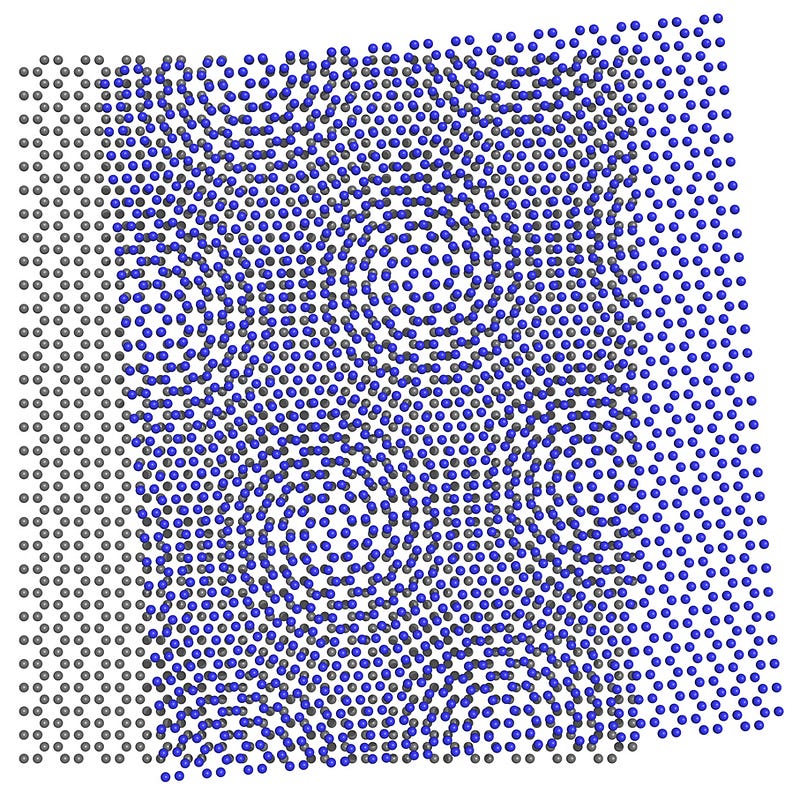Fat stacks of thin materials: The rich phenomena of twisted 2D layers
By Jennifer Garland, Applied Physics and Mathematics, 2021

This article was originally published as part of Issue 40: Wonder.
For most of the history of materials science, layered crystal growth has been limited to the particular arrangements in which atoms tend to align. Professor Pablo Jarillo-Herrero, an experimental condensed matter physicist at MIT, compares layered crystal growth to stacking Legos. Each layer of atoms had to be stuck on the next with zero degrees rotation. However, at the 2018 American Physical Society (APS) March Meeting, Jarillo-Herrero and his group presented a technique to control the angle between two graphene sheets, creating what is called twisted bilayer graphene. Interesting phenomena arose with this unprecedented tunability in layering materials, including most notably, superconductivity, the complete lack of electrical resistance, at a “magic angle” of about 1.1 degrees.
Since then, the physics community has focused on developing theories and experiments in a new field known as “electron quantum metamaterials.” It covers materials that do not occur in nature and have been engineered to obtain emergent electronic properties. Van der Waals heterostructures, stacks of atomically-thin materials held together by electrical attractions between molecules, such as twisted bilayer graphene, are just one subset of examples.
“The thing which is interesting and relevant and has attracted a lot of attention is the fact that we can play with this twist angle degree of freedom, so another word that people use to refer to this field is called ‘twistronics’ — twist angle electronics,” said Jarillo-Herrero. “If you rotate by an angle, you form a moiré pattern, a super-periodic structure.” Moiré patterns occur when two geometric patterns are overlaid and offset. When the hexagonal patterns in graphene are offset by a small angle, the two sheets interact more strongly, giving the system new properties. A single sheet of graphene is the best regular conductor we know of, but depending on the twist between two sheets and their charge, the combination can become either an insulator or a superconductor.
When the hexagonal patterns in graphene are offset by a small angle, the two sheets interact more strongly, giving the system new properties.
A team of researchers led by Professor Matthew Yankowitz at Columbia University showed that applying pressure to two stacked graphene sheets allows electrons to move between layers more easily. For different pressures, different twist angles cause superconductivity. The experiments at MIT were conducted at ambient pressure, and this evidence that the pressure is a relevant variable confirmed that the properties are dependent on interlayer coupling.
Much is still to be understood, and Jarillo-Herrero describes a few categories of exploration. “One is to further study the properties of graphene at the magic angle. Many of the experiments that we and many other people are doing are trying to better understand the physics of this particular system,” he said.
Another is experimenting with more than two layers. A year after the initial announcement, at the 2019 APS March Meeting, new research was presented on twisted bilayer-bilayer graphene: two bilayers, each stacked with zero angle between them, that are then rotated with respect to one another. At particular angles in this system, interesting correlated physics arises at a larger range of twist angles, improving upon the 0.2 degree range of twisted bilayer graphene. The ability to stack multiple layers introduces many degrees of freedom, as each can be twisted with respect to the others. Theorists are currently investigating these combinations in hopes of creating a more robust kind of superconductivity.
The ability to stack multiple layers introduces many degrees of freedom, as each can be twisted with respect to the others.
Additionally, the investigations are not just limited to graphene. Any other 2D material, such as transition metal dichalcogenides, can be manipulated in the same way, and superconductivity has also arisen in these systems at certain twist angles. Due to the vast array of customizable features and potential phenomena, van der Waals heterostructures have become an influential gateway to new nanotechnology for electricity transmission and information processing.
“Each 2D material brings a new or unique flavor,” said Jarillo-Herrero. “The whole community is playing with 2D materials, twisting them, and seeing what happens, and, as you can imagine, the possibilities are infinite.”
Nature (2018). DOI: 10.1038/nature26160
Science (2019). DOI: 10.1126/science.aav1910
